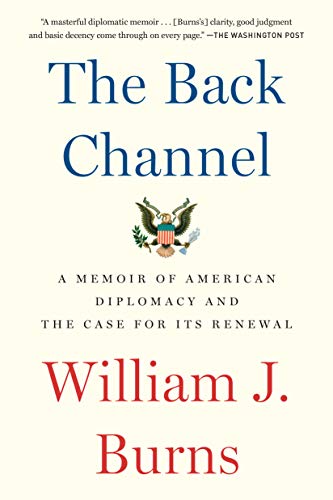There’s nothing better than sitting under your favorite tree in a backyard or out on the balcony with the sun in your face reading an engaging and enlightening book. As I have mentioned previously, Summer is the best season for reading and since a lot of other summer activities are postponed or cancelled, why not catch up on some reading? Regardless if the book is fiction or non-fiction, spending a few hours each day reading a good book can make the time pass by quicker and get rid of any kind of twiddle-your-thumbs moments that can happen when you don’t have a movie, concert, or sporting event to distract you. While live events may be out of order this summer, your bookshelf is dying to have you open up a book, sit down on your favorite couch or chair, and let your mind wander to an imaginary or a real place to pass the time.
- The Back Channel: A Memoir of American Diplomacy and The Case for Its Renewal by William J. Burns

William J. Burns might be one of the best diplomats the United States has ever had. With over thirty years of experience and having served in two of the most important regions of the world, Mr. Burns’s story is an example of the good that diplomatic efforts can do in resolving conflicts, promoting peace, and ensuring cooperation among both allies and adversaries. He is one of only two career diplomats to have ever earned the title of ‘Deputy Secretary of State’ and he gave advice and counsel to five U.S. Presidents and ten Secretaries of State.
Mr. Burns’s storied career includes Ambassadorships to both Jordan and Russia and he held numerous Assistant Secretary positions within the State Department during his three-decade tenure. He was partly responsible for ceasefire agreements between the Israelis and the Palestinians, for helping to eliminate Libya’s nuclear weapons program, and for helping to reset U.S. relations with Russia in the early 2010s. He also shares insights in this book that were previously not publicly known involving his views on the Iraq War, the Civil War in Syria, and of the Russian aggression against Ukraine at the end of his tenure.
This 400+ page memoir is simply a must-read for anyone interested in how diplomacy works and how vital it is to maintain within a government’s foreign policy. In a time now where it has been underinvested and mismanaged, Burns’s book illuminates how big of a difference it can make and how one man’s impact can be felt throughout an entire foreign policy apparatus due to his vigorous study of culture, languages, and history in order for him to be taken seriously. The book is not only educational but is also gripping in terms of his recall of major events throughout his diplomatic career as well as the written cables that explain them. It is a real page turner and should be required reading for any student of international relations and who hopes to become a diplomat in their own future career.
2. On the Plain of Snakes: A Mexican Journey by Paul Theroux

Cooperation, friendship, and understanding is important among friends, but it is even more important among your neighbors. The US-Mexico relationship has been fraught with mistrust and tension especially during the years of the Trump administration. The best way to do away with stereotypes and misgivings about each other is to visit the lesser known places of a country and visit the non-touristy areas. Paul Theroux may be the best living American travel writer today.
From his experience as a Peace Corps volunteer in Malawi in the 1970s to his trek in the American Deep South, Paul Theroux has traveled around the world over five decades and counting. His latest novel about his travels in Mexico is a must-read for Americans and anyone else looking to understand Mexico from an outside lens. While not an exhaustive take on the complex country and its people, Theroux’s book, somewhat observant and otherwise felt like you’re in the middle of his travels is both illuminating and powerful.
Paul Theroux is really a true traveler and even though this is the first of his travel novels that I have read, this one felt very timely as it was released in 2019 during a time of souring relations between the two North American neighbors. Theroux spares no miles or kilometers in seeing all of Mexico that he can. From the desert Region of Sonora in the North to the Mexico mundo of Mexico City to the Southeast of the country where he visits the Zapatistas, this is an extremely educational look at modern Mexico.
Theroux’s book highlights the issues that Mexico is going through from immigration from the Northern Triangle to the ever-present threat of the drug cartels to the hopes of Mexico’s indigenous populations who believe that they have been left behind as other villages and towns hollowed out while the economic gains went elsewhere. It’s not just the issues that Theroux shines a lens on but also the beauty of the country’s culture and its warm people. As an elderly traveler, Theroux is treated with great respect and even reverence as ‘Don Pablo.’
He is welcomed as a guest, kept safe by complete strangers, and invited to interview Mexicans who normally would not talk to foreign travelers. Theroux travels all the way from Massachusetts across the border where few Americans are found to cross. He does so in his own car on his own dime and does not travel with any security or any kind of companionship. He learns Spanish and teaches writing to Mexican students. He is a refreshing kind of traveler, one who remembers to show people through a human lens and to not deal with harmful stereotypes.
Overall, ‘On the Plain of Snakes’ is an excellent travel novel for anyone interested in learning more about Mexico’s people, its culture, its struggles, and its hopes for a better future.
3. Rule Makers, Rule Breakers: How Tight and Loose Cultures Wire Our World by Michele J. Gelfand

This book has been my favorite one of 2020 and I only heard of it through a weekly David Brooks column in The New York Times Opinion section. The differences and similarities between cultures and societies is a topic that has fascinated me for years. As someone who has lived in both loose and tight countries as Mrs. Gelfand so brilliantly classifies, it is fascinating to see her extensive research come into fruition and how these loose and tight countries affect our outlook on everything from celebrations to driving to health care to tattoos.
Tight countries are cultures where norms are preserved and breaking them is frowned upon. Societal cohesion is encouraged and straying from norms is open to punishment. Loose countries are cultures where norms are often broken and breaking them usually comes with a shrug or a lack of care. Why do Germans always stop at a red light even when its 3 AM? Why do Brazilian clocks never run on time? Why do Japanese trains always run on time? Why do Singaporean laws ban gum from being chewed?
These tight and loose differences do not just extend to countries but also to states, cities, organizations, businesses and even within us. This book of ‘tight and loose’ norms highlights how we feel about any subject and how that is reflected in how we act with others. There is no right or wrong answer as to whether living in a tight culture is better or if living in a loose culture is better. Mrs. Gelfand excellently points out in each chapter how they both have their advantages and disadvantages depending upon the norm being considered.
Our upbringing, our environment, our country’s history, etc. all have effects on how ‘tight’ a culture is or how ‘loose’ a culture is. There can also be changes to a culture depending if there are big events like a terrorist attack, a pandemic, a natural disaster, etc. Cultures can tighten or loosen depending upon what is going on in the country and how people are being affected by these natural or manmade shifts to our lives.
Having seen both ‘tight cultures’ and ‘loose cultures’ up close and personal, this book has been a revelation to me in terms of explaining what I thought about only in my theories that I concocted after traveling from country to country but never really expressing it as well as she has in this great book. Mrs. Gelfand has done extensive research across many countries and continents to explain why some countries have more ‘rule makers’ and why other countries have ‘rule breakers.’ In order for our own cultures to shift from one spectrum to the other, we have to first understand why the country’s culture is the way it is and if it can shift, what benefits are there to tightening up or loosening up depending on what is going on in our lives and in our society at the time?


